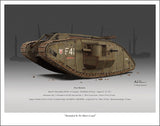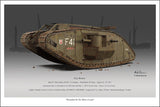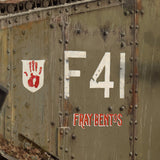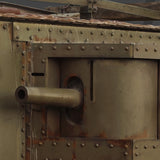Introduced during World War I, The Mark IV was an evolution of the world’s first tank, the Mark I. It featured improved armor and two 6 pdr 6 cwt guns and three .303 Lewis guns. Powered b a gasoline engine producing only 105 BHP, the tank was very underpowered for its 28 ton mass, having a maximum speed of only 4 MPH. Crewed typically by 8 men, conditions inside the vehicle were cramped and extremely hot with men sharing the space with the engine and fumes of the guns firing.
Tank F41 was a Mark IV Tank, #2329 which took part in the Battle of Passchendaele. It was captained by Donald Richardson who wryly named the tank “Fray Bentos,” after the canned meat his family sold at their store. The other crew were Lt. George Hill, Sgt. Robert Missen, Lance Cpl. Hans Braedy, gunners William Morrey, Frederick Arthurs, Ernest Hayton, James Binley and Percy Budd.
During the early morning hours of August 22, 1917, “Fray Bentos” and its 9 man crew set off across No Man’s Land in support of an attack by the British 61st Division, near St. Julien. Captain Richardson initially walked beside the tank. The crew effectively eliminated one German machine gun position but Captain Richardson has to take refuge inside the tank having been shot in the leg when the tank came under a second attack. At this time, driver Lt. George Hill was wounded in the neck and blown off his seat resulting in the tank sliding sideways into a ditch.
Sgt. Robert Missen, Lance Cpl. Hans Braedy went outside the tank in an attempt to deploy the unditching beam carried on the roof only to come under German fire. The men in the tank returned fire however Braedy was killed. His body sank into the mud. It was never found.
By 7:00 AM, the attack had stalled. The British infantry began falling back to their trenches which left Fray Bentos stranded alone in No Man’s Land. The crew held off the enemy with their Lewis guns as best as possible but eventually the Germans were able to approached the tank engaging its crew in close combat. Before long, most of the men had been wounded.
Over the next three days and two nights, the crew fought off German attacks. The crew also came under fire from British snipers, who believed them to be German soldiers attempting to steal the stuck tank. Robert Missen volunteered to crawl back to the trenches. The crew also showed a white rag from one of the portholes and the sniping from the British stopped. To survive, the men drained drank water drained from the tank radiator and filthy ground water.
After the third day, the crew to dismantled the tank’s cannons and, during the night hours, gathered their weapons and maps and painfully crawled their way back to the British side.
The crew of “Fray Bentos” were decorated for their actions during the Battle of Passchendaele with Richardson and Hill receiving the Military Cross. Missen and Morrey were awarded the Distinguished Conduct Medal for their bravery and the other surviving gunners were presented with the Military Medal. The men of the Fray Bentos were the most decorated tank crew of the war and the ordeal was also the longest single tank action of the war.
There are no surviving photographs of Fray Bentos. This artwork is a depiction of the machine as it may have appeared during the above described action surmising it to be similarly marked as a later tank named “Fray Bentos II”.








